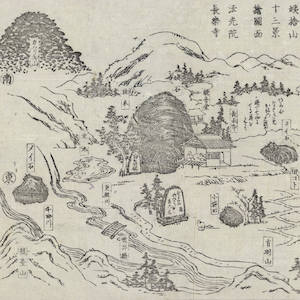Japanese Historical Maps
This collection contains high quality digital reproductions of roughly 100 historical maps produced in Japan from the 17th century to the 20th century. The original copies of the maps are held in the East Asian Library at the University of California at Berkeley. The David Rumsey Map Collection has digitized the maps and has made them available online.
The collection rewards the viewer with an array of fascinating, beautiful maps. The majority of the maps are of cities or regions of Japan, but there are also maps of China and East Asia, as well as a few global maps from the late 19th century. Most maps are woodblock printed, created during the Tokugawa period (1600-1868), when urbanization and the growth of a commercial publishing industry turned maps into popular commodities. There are also several maps from the Meiji period (1868-1912), during which European and American cartographic techniques became widespread in Japan. The maps are shown both in their cover and unfolded, so that the viewer can get a better sense of the map itself as a historical artifact-an item that people purchased and placed in their pockets and stored on bookshelves.
The site is relatively easy to use, although it requires a little time to learn all of its different features and functions. Search for maps by country, province, author, or keyword. The site then retrieves thumbnail images of maps that match the search term. Or, browse thumbnail images of all maps in the collection. Clicking on the thumbnails opens a larger version with information about the map and zoom capabilities. The maps have been scanned at a very high resolution; as a result, users can zoom in repeatedly without losing clarity. Place names that appear impossibly small when looking at the entire map can thus be rendered legible (in Japanese). One could spend hours exploring a single map, uncovering unexpected and colorful details in every corner.
Different audiences will find different uses for the site. The site will be a valuable resource for historians. Scholars studying the Tokugawa period, in particular, now have easy access to detailed information about the urban geography of major early modern Japanese cities. Furthermore, they can trace how those cities changed over time—comparing, for example, a 1657 map of Osaka with a 1913 map. Teachers of world history should also find the site useful. At the very least, the site provides vivid visual aids to enliven lectures on early modern urban society and culture in East Asia. More broadly, teachers can use the maps to demonstrate different ways in which people conceptualize geographic space. Teachers might, for example, compare the maps on this site with European maps from the same era when discussing how different cultures visualized the place of the nation within the larger world. Teachers might also use the maps to point out how mapped space became increasingly abstract over time, largely under the influence of the modern cartographic imagination. For example, castles—once drawn on Japanese city maps in elaborate, colorful detail—are, by the late 19th century, signified simply by the castle name or perhaps by a generic symbol of a castle. The richness of these sources, along with the extraordinarily high quality of their reproduction, make this site an invaluable tool for anyone who studies or teaches Japan and East Asia.
